1960s in music
| Popular music |
|---|
 |
| Timeline of musical events |
|
|
List of popular music genres |
This article includes an overview of the events and trends in popular music in the 1960s.
In
In
In South America, genres such as bossa nova, Nueva canción and Nueva ola started to rise. Rock music began leaving its mark, and achieved success in the 1960s. Additionally, salsa grew popular towards the end of the decade.[7] In the 1960s cumbia entered Chile and left a long-lasting impact on tropical music in that country.[10]
United Kingdom
Beat music and the British Invasion

In the late 1950s, a flourishing culture of groups began to emerge, often out of the declining

By the end of 1962, the British rock scene had started with beat groups like the Beatles drawing on a wide range of American influences including soul music, rhythm and blues and surf music.[15] Initially, they reinterpreted standard American tunes, playing for dancers doing the twist, for example. These groups eventually infused their original rock compositions with increasingly complex musical ideas and a distinctive sound. In mid-1962 the Rolling Stones started as one of a number of groups increasingly showing blues influence, along with bands like the Animals and the Yardbirds.[16] During 1963, the Beatles and other beat groups, such as the Searchers and the Hollies, achieved great popularity and commercial success in Britain itself.
British rock broke through to mainstream popularity in the United States in January 1964 with the success of the Beatles. "I Want to Hold Your Hand" was the band's first No. 1 hit on the Billboard Hot 100 chart, starting the British Invasion of the American music charts.[17] The song entered the chart on January 18, 1964, at No. 45 before it became the No. 1 single for 7 weeks and went on to last a total of 15 weeks in the chart.[18] Their first appearance on The Ed Sullivan Show February 9 is considered a milestone in American pop culture. The broadcast drew an estimated 73 million viewers, at the time a record for an American television program. The Beatles went on to become the biggest selling rock band of all time and they were followed by numerous British bands.[19]

During the next two years, Chad & Jeremy, Peter and Gordon, the Animals, Manfred Mann, Petula Clark, Freddie and the Dreamers, Wayne Fontana and the Mindbenders, Herman's Hermits, the Rolling Stones, the Troggs, and Donovan would have one or more No. 1 singles.[17] Other acts that were part of the invasion included the Kinks and the Dave Clark Five.[20] British Invasion acts also dominated the music charts at home in the United Kingdom.[16]
The British Invasion helped internationalize the production of rock and roll, opening the door for subsequent British (and Irish) performers to achieve international success.[21] In America it arguably spelled the end of instrumental surf music, vocal girl groups and (for a time) the teen idols, that had dominated the American charts in the late 1950s and 1960s.[22] It dented the careers of established R&B acts like Fats Domino and Chubby Checker and even temporarily derailed the chart success of surviving rock and roll acts, including Elvis Presley.[23] The British Invasion also played a major part in the rise of a distinct genre of rock music, and cemented the primacy of the rock group, based on guitars and drums and producing their own material as singer-songwriters.[24]
British blues boom
In parallel with Beat music, in the late 1950s and early 1960s a British blues scene was developing recreating the sounds of American
A number of these moved through blues rock to different forms of rock music and as a result British blues helped to form many of the subgenres of rock, including psychedelic rock and heavy metal music. Since then direct interest in the blues in Britain has declined, but many of the key performers have returned to it in recent years, new acts have emerged and there have been a renewed interest in the genre.[25]
British psychedelia
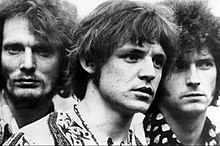
British psychedelia emerged during the mid-1960s, was influenced by
North America
Folk music

The
Rock
Roy Orbison was one of rock's famous artists who wrote ballads of lost love.
In the early part of the decade, Elvis Presley continued to score hits. For most of the 60s, Presley mostly released films. Presley decided to get away from films by 1969; his last #1 song on the charts was Suspicious Minds which was released in 1969.

By the 1960s, the scene that had developed out of the
By the mid-'60s Bob Dylan took the lead in merging folk and rock, and in July '65, released Like a Rolling Stone, with a revolutionary rock sound, steeped in tawdry urban imagery, followed by an electric performance later that month at the Newport Folk Festival. Dylan plugged an entire generation into the milieu of the singer-songwriter, often writing from an urban point of view, with poetry punctuated by rock rhythms and electric power. By the mid to late '60s, bands and singer-songwriters began to proliferate the underground New York art/music scene.
The release of
Folk rock reached its peak of commercial popularity in the period 1967–68, before many acts moved off in a variety of directions, including Dylan and the Byrds, who began to develop country rock.[36] However, the hybridization of folk and rock has been seen as having a major influence on the development of rock music, bringing in elements of psychedelia, and in particular, helping to develop the ideas of the singer-songwriter, the protest song and concepts of "authenticity".[30][37]
Psychedelic rock
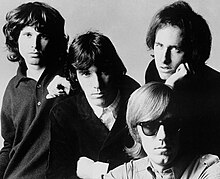
Psychedelic music's
Psychedelic rock particularly took off in California's emerging music scene as groups followed the Byrds from folk to folk rock from 1965.

Psychedelic rock reached its apogee in the last years of the decade. In America the
Surf rock

In the early 1960s, one of the most popular forms of
Duane Eddy's "Movin' and Groovin" is thought by many to be the main contender for laying the groundwork as the first surf rock record, while others claim the genre was invented by Dick Dale on "Let's Go Trippin'", which became a hit throughout California. Most early surf bands were formed during this decade in the Southern California area. By the mid-1960s the Beach Boys, who used complex pop harmonies over a basic surf rock rhythm,[47] had emerged as the dominant surf group and helped popularize the genre[48] in hits like Surfin' U.S.A. In addition, bands such as the Ventures, the Shadows, the Atlantics, the Surfaris and the Champs were also among the most popular Surf Rock bands of the decade.
Garage rock
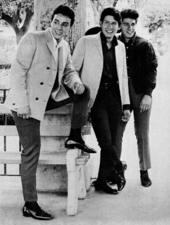
Garage rock was a raw form of rock music, particularly prevalent in North America in the mid-1960s and is called such because of the perception that many of the bands rehearsed in a suburban family garage.[49][50] Garage rock songs often revolved around the traumas of high school life, with songs about "lying girls" being particularly common.[51] The lyrics and delivery were notably more aggressive than was common at the time, often with growled or shouted vocals that dissolved into incoherent screaming such as the influential Washington based band, The Sonics.[49] They ranged from crude one-chord music (like the Seeds) to near-studio musician quality (including the Knickerbockers, the Remains, and the Fifth Estate). There were also regional variations in many parts of the country with flourishing scenes particularly in California and Texas.[51] The Pacific Northwest states of Washington and Oregon had perhaps the most defined regional sound.[52]
The style had been evolving from regional scenes as early as 1958. "
The British Invasion of 1964–66 greatly influenced garage bands, providing them with a national audience, leading many (often
Blues-rock

The American blues-rock had been pioneered in the early 1960s by guitarist
Roots rock
Roots rock is the term now used to describe a move away from the excesses of the psychedelic scene, to a more basic form of rock and roll that incorporated its original influences, particularly country and folk music, leading to the creation of country rock and Southern rock.

In 1968,
The founders of
Progressive rock

Progressive rock, sometimes used interchangeably with
Instrumentals were common, while songs with lyrics were sometimes conceptual, abstract or based in
Pop

The

"
The Monkees were a made for TV band, inspired by the antics of the Beatles in A Hard Day's Night. Under contractual reasons, the group were not allowed to play their own instruments, which led to many feuds between the bandmates and music supervisor, Don Kirshner.
The Monkees and The Archies were not unique; in fact, bands not playing their instruments on record was not unusual. Producers like Mickie Most regularly used experienced session musicians whose discipline helped produce a number of tighter-sounding commercial recordings within one time-limited studio session (typically 3 hours).
Studios and producers regularly experimented with session singers and musicians to create a hit. One example was Ohio Express. A single by The Rare Breed, "Beg Borrow And Steal", was picked up by a production company. They remixed the track and credited a new single to Ohio Express" – a name they wholly owned. when it became a hit, the production company quickly assembled a touring band (whose members became the bands' public identity), while making their recordings using other acts or collectives of session musicians as and when available.
R&B, Motown and soul music
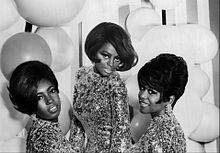
- The Detroit-based Jackson Five, who debuted in 1969.
- Soul music developed popularity throughout the decade, with Atlantic Records as the key label and Solomon Burke as a key figure in the emergence of soul music as an established movement. Ben E. King also achieved success in 1961 with "Stand By Me", a song directly based on a gospel hymn. By the mid-1960s, the initial successes of Burke, King, and others had been surpassed by soul singers such as Sam Cooke, James Brown and Otis Redding.
- The most important female soul singer to emerge was apogeeof the soul genre, and were among its most commercially successful productions.
- By 1968, while at its peak of popularity, soul began to fragment into disparate subgenres. Artists such as James Brown and Sly and the Family Stone evolved into funk music, while other singers such as Marvin Gaye, Stevie Wonder, Curtis Mayfield and Al Green developed slicker, more sophisticated – and in some cases more politically conscious – varieties of the genre. However, soul music continued to evolve, informing most subsequent forms of R&B from the 1970s-onward, with pockets of musicians continuing to perform in a traditional soul style.
- In the UK, Dusty Springfield helped popularise soul music – merged with pop – and became one of the most popular female performers on both sides of the Atlantic. One of her defining works was the 1968 album Dusty in Memphis, featuring her signature song "Son of a Preacher Man", an international hit (UK no.9/Us no. 10).
Country music

Triumph and great tragedy marked the 1960s in country music. The genre continued to gain national exposure through network television, with weekly series and awards programs gaining popularity. Sales of records continued to rise as new artists and trends came to the forefront. However, several top stars died under tragic circumstances, including several who were killed in plane crashes.
The predominant musical style during the decade was the

By the end of the decade, the Nashville Sound became more polished and streamlined, and became known as "countrypolitan." Tammy Wynette, Glen Campbell, Dottie West and Charley Pride were among the top artists adopting this style. While George Jones — by the early 1960s one of country music's most consistent hitmakers — also recorded countrypolitan-styled music, his background remained pure honky tonk, singing of heartbreak and loneliness in many of his songs. Also, Marty Robbins proved to be one of the genre's most diverse singers, singing everything from straight-ahead country to western to pop to blues ... and even Hawaiian.
During the latter half of the 1960s, Pride — a native of
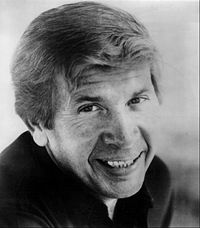
A newly emerging style, which had its roots in the 1950s but exploded in the mainstream during the 1960s, was the "Bakersfield sound." Instead of creating a sound similar to mainstream pop music, the Bakersfield sound used honky tonk as its base and added electric instruments and a backbeat, plus stylistic elements borrowed from rock and roll. Buck Owens, Merle Haggard and Wynn Stewart were some of the top artists adopting this sound, and by the late 1960s they were among country music's top selling artists.
The 1960s also marked the rise of a young Abbott, Texas, songwriter named Willie Nelson. Starting as a disc jockey in the late 1950s, he began honing his craft and wrote his first hit, "Family Bible," which he sold the rights to guitar instructor Paul Buskirk before it eventually became a hit for Claude Gray in 1960. By early 1961, Nelson's songwriting was gaining national attention, as several of his songs became country standards: "Funny How Time Slips Away", "Hello Walls", "Pretty Paper", "Night Life" and "Crazy" ... all of them for other artists including – respectively – Billy Walker, Faron Young, Roy Orbison, Ray Price and Patsy Cline. He recorded an album, ...And Then I Wrote, and eventually signed with RCA Records, but during most of the 1960s, most of his single releases were mid-chart hits at best; his recording career would not come to full fruition until the mid-1970s, after he became associated with the outlaw movement.
Among female acts, the most successful of the lot were
Parton, a native of the
Wynette gained acclaim with unique perspectives on the classic themes of loneliness, divorce, and the difficulties of life and relationships, illustrated by songs such as "

Among other female newcomers, Connie Smith was among the most successful, as her breakthrough hit, "Once a Day" spent eight weeks at No. 1 on the Billboard Hot Country Singles chart in late 1964 and early 1965, the longest-running chart-topper for nearly 50 years. During a career that has spanned 50-plus years, Smith's songs often explored themes of loneliness and vulnerability.
In addition to the
The 1960s were marred with tragedy.
The 1960s began a trend toward a proliferation of No. 1 hits on the Billboard Hot Country Singles chart, thanks to ever-changing data collecting methods. When the 1960s decade opened, there were but four No. 1 songs topping the chart (five, if one counts Marty Robbins' "El Paso"), but by the mid-1960s, there were always at least a dozen songs topping the chart annually. In 1967, there were more than 20 songs reaching the top spot for the first time ever in a single calendar year ... and that number would only continue to rise during the next 20 years.
Toward the end of the decade, modern fashion trends began to make its way into country music circles. This was specifically inspired by a song, "
It was attention to detail in songs like "Harper Valley PTA" that made Hall one of the genre's most renowned songwriters, starting in mid-1960s, and earned him the nickname "The Storyteller." His first hits were as a songwriter, with "Hello Vietnam," recorded by Johnnie Wright (husband of Kitty Wells), becoming Hall's first songwriting No. 1 single in 1965. By the late 1960s, Hall began having hits of his own, with songs like "The Ballad Of Forty Dollars" and "Homecoming" both becoming top-10 hits and showcasing his storytelling talents, and that success continued throughout the 1970s and into the 1980s.
Other trends and musical events
- Late in the decade, the Woodstock Music Festival[46] would epitomize the American counterculture.
- Current events become a major influence on popular music. Many songs are written in protest to the Crosby, Stills, Nash and Young.
- Latin Rock artist Carlos Santana sees popularity throughout the decade. George Harrison develops an interest in the Hare Krishna culture, adding Indian influence to the Beatles' music including the use of a sitar. Reggaebegins to popularize at this time.
- In 1969, the Rolling Stones organized the ill-fated Altamont Free Concert.
- Songs like "Summertime Blues" and "Eve of Destruction" address the issue of the voting age, which at the time was 21. The issue was that soldiers were drafted at 18, but could not vote. The voting age was eventually lowered to eighteen.
- A few songs such as Bob Dylan's "Civil Rights Movement.
Latin America, Spain and Brazil
Bossa Nova
This Brazilian musical style, which means "New Trend", had its origins in the upscale neighbourhoods of
Romantics
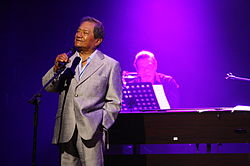
Another composer Armando Manzanero widely considered the premier Mexican romantic composer of the postwar era and one of the most successful composers of Latin America has composed more than four hundred songs, fifty of which have given him international fame. His most famous songs include Voy a apagar la luz (I'm Going to Turn Off the Lights), Contigo Aprendí (With you I Learnt... ), Adoro (Adore), No sé tú (I don't know if you...), Por Debajo de la Mesa (Under the Table) Esta Tarde Vi Llover (English version "Yesterday I Heard the Rain"), Somos Novios (English version "It's Impossible"), Felicidad (Happiness) and Nada Personal (Nothing Personal).
Some renowned trios romantics were Trio Los Panchos, Los Tres Ases, Los Tres Diamantes and Los Dandys. Trio Bolero, a unique ensemble of two guitars and one cello. Other singers in singing boleros in Mexico are Óscar Chávez, José Ángel Espinoza and Álvaro Carrillo.
Nueva ola

It was during the 60s that rock music began to gain acclaim in Latin America. In Spanish speaking South America musicians who adopted US and British inspired rock, mainly
Nueva canción
During the 1960s
Salsa
Even though salsa music began to take form in a New York scene dominated by Cubans and other Latin American communities, Salsa would not become popular all across Latin America until the late 1980s and is now here today.
Tango
Astor Piazzolla won the First Ibero American Music Festival in 1966 with the song "Balada para un loco", that launched him worldwide introducing his New Tango style Nuevo Tango
Música cebolla
Música cebolla, a style of music loaded with sentimentality, had its heyday in Chile despite being derided or ignored by mass media.[79]
Australia and New Zealand
The 1960s saw increasing interest in how electronic music could solve both compositional and more practical problems. Composers were also absorbing ideas from overseas, such as indeterminacy and electro-acoustic music, and interpreting them in an Australian context to mixed responses from local audiences.
Early in the decade, Bruce Clarke began toying with the new
After working among the musical avant-garde in Paris, Keith Humble's return to Australia helped to encourage educational institutions to take electronic music seriously. Humble's most notably experimental work was his Nunique series. These vast multimedia events featured simultaneous performances by rock bands, string quartets and theatre ensembles, all according to precise flowcharts.
Humble initiated the Melbourne-based Society for the Private Performance of New Music in 1966, providing a supportive performance space for young innovators both in and outside the academy. Among these were the McKimm/Rooney/Clayton trio, who, since the 1964, had been incorporating graphic scores and aspects of serialism into jazz improvisation. Jazz was radicalizing at the fringes: John Sangster explored free jazz concepts and Charlie Munro incorporated Eastern musical elements. Syd Clayton would leave jazz behind in pursuit of a new form of experimental music theatre that incorporated chance operations along with sports and games as musical structures.
Young composers, like
Legacy

It is difficult to determine the lasting impact of 1960s music in popular culture. A 2010 European survey conducted by the digital broadcaster Music Choice, interviewing over 11,000 participants, rated the decade rather low, with only 19% declaring it the best tune decade in the last 50 years,[80] while participants of an American land line survey rated the 1960s a bit higher, with 26% declaring it as best decade in music.[81]
The song Vivo cantando was joint winner of the Eurovision Song Contest with the United Kingdom's "Boom Bang-a-Bang" performed by Lulu, "De troubadour" by Lenny Kuhr representing the Netherlands, and "Un jour, un enfant" sung for France by Frida Boccara. It was Spain's second winning entry in the contest and the last to date.[citation needed]
See also
References
- ISBN 978-1-4422-5311-7.
- ^ "Singer/Songwriter – Significant Albums, Artists and Songs – AllMusic". AllMusic. Retrieved 27 September 2014.
- ^ "Baroque Pop – Significant Albums, Artists and Songs – AllMusic". AllMusic. Retrieved 27 September 2014.
- ^ "Sunshine Pop – Significant Albums, Artists and Songs – AllMusic". AllMusic. Retrieved 27 September 2014.
- ^ "Bubblegum – Significant Albums, Artists and Songs – AllMusic". AllMusic. Retrieved 27 September 2014.
- ^ "Girl Groups – Significant Albums, Artists and Songs – AllMusic". AllMusic. Retrieved 27 September 2014.
- ^ a b "Cha-Cha – Significant Albums, Artists and Songs – AllMusic". AllMusic. Retrieved 27 September 2014.
- ^ "AllMusic". AllMusic. Retrieved 27 September 2014.
- ^ "AllMusic". AllMusic. Retrieved 27 September 2014.
- ^ "Tropical". MusicaPopular.cl. Archived from the original on 19 June 2013. Retrieved 11 April 2013.
- ^ Mersey Beat – the founders' story[permanent dead link].
- ^ W. Everett, The Beatles as musicians: the Quarry Men through Rubber Soul (Oxford: Oxford University Press, 2001), pp. 37–8.
- ^ Daily Telegraph[dead link] "'Dreamers' star Freddie Garrity dies", 20 May 2006, accessed August 2007.
- ^ Bogdanov, Woodstra & Erlewine 2002, p. 532
- ISBN 0-85323-727-1, pp. 157–66.
- ^ a b "British Invasion", AllMusic, retrieved 29 January 2010.
- ^ a b "British Invasion" Encyclopædia Britannica, retrieved 29 January 2010.
- ISBN 0-7137-1521-9, p. 66.
- ^ Bogdanov, Woodstra & Erlewine 2002, pp. 1316–7
- ^ T. Leopold, "When the Beatles hit America CNN February 10, 2004", CNN.com, retrieved 1 February 2010.
- ^ "Britpop", AllMusic, retrieved 11 October 2006.
- ISBN 0-521-55660-0, p. 117.
- ISBN 0-415-93835-X, p. 132.
- ISBN 0-415-34770-X, p. 35.
- ^ V. Bogdanov, C. Woodstra, S. T. Erlewine, eds, All Music Guide to the Blues: The Definitive Guide to the Blues (Backbeat, 3rd edn., 2003), p. 700.
- ^ Gilliland 1969, shows 18–19.
- ^ ISBN 0-7546-5756-6, p. 95.
- ISBN 0-7546-5756-6, p. 72.
- ISBN 0-313-32689-4, p. 37.
- ^ a b c d e f Bogdanov, Woodstra & Erlewine 2002, pp. 1308–9
- ^ Dave Marsh, The Heart of Rock & Soul: The 1001 Greatest Singles Ever Made, NAL, 1989. Entry #91.
- ^ https://www.rollingstone.com/news/story/5938174[permanent dead link] 13-The Velvet Underground and Nico Rolling Stone, November 1, 2003
- ^ Saal, Hubert (July 14, 1969). " The Girl's-Letting Go". Newsweek, pp. 68,71.
- ^ JoniMitchell.com Library: THE GIRLS—LETTING GO: Newsweek, July 14, 1969 [1]
- ^ JoniMitchell.com Library: THE GIRLS—LETTING GO: Newsweek, July 14, 1969, Original Article pdf [2]
- ISBN 0-520-21800-0, p. 201.
- ISBN 0-521-55660-0, p. 121.
- ^ ISBN 0-252-06915-3, pp. 59–60.
- ^ a b c d Bogdanov, Woodstra & Erlewine 2002, pp. 1322–3
- ^ Ruhlmann, William; Unterberger, Richie. "The Doors – Biography". AllMusic. Retrieved March 29, 2021.
- ^ Gilliland 1969, shows 41–42.
- ^ Gilliland 1969, show 35.
- ^ a b Gilliland 1969, show 47.
- ISBN 0-7890-0151-9, p. 223.
- ISBN 0-313-32689-4, p. 24.
- ^ a b Gilliland 1969, show 55.
- ^ a b Gilliland 1969, show 20
- ^ Gilliland 1969, show 37.
- ^ ISBN 0-415-34770-X, p. 140.
- ISBN 0-7864-2564-4, pp. 74–6.
- ^ a b c d e f g Bogdanov, Woodstra & Erlewine 2002, pp. 1320–1
- ISBN 0-7486-1933-X, p. 213.
- ISBN 0-7890-0151-9, p. 213.
- ISBN 1-55652-572-9, p. 19.
- ISBN 0-520-25310-8, p. 116.
- ^ W. Osgerby, "'Chewing out a rhythm on my bubble gum': the teenage astheic and genealogies of American punk," p. 159, in Sabin 1999.
- ISBN 0-7486-1910-0, p. 134.
- ISBN 0-7935-4042-9, p. 25.
- ISBN 0-87930-736-6, pp. 700–2.
- ^ Bogdanov, Woodstra & Erlewine 2002, p. 1333
- ISBN 0-415-77353-9, p. 83.
- ^ ISBN 1-85828-534-8, p. 392.
- ^ Bogdanov, Woodstra & Erlewine 2002, pp. 61 and 265
- ISBN 0-470-12777-5, pp. 87–90.
- ^ a b c d e f g Bogdanov, Woodstra & Erlewine 2002, p. 1327
- ISBN 1-84353-105-4, p. 730.
- ISBN 0-8108-5295-0, pp. 227–8.
- ^ a b c d Bogdanov, Woodstra & Erlewine 2002, pp. 1332–3
- ^ a b c Bogdanov, Woodstra & Erlewine 2002, pp. 1330–1
- ISBN 0-634-02861-8, p. 191.
- ISBN 0-19-509887-0, pp. 34–5.
- ISBN 0-19-509887-0, p. 64.
- ^ "Progressive rock", AllMusic, retrieved 29 October 2009.
- Nielsen Company. 1966. p. 26. Retrieved May 10, 2011.
- ^ Gilliland 1969, shows 10–11.
- ^ Gilliland 1969, show 16.
- ^ Gilliland 1969, shows 8, 10.
- ^ HLT. "El Rock Progresivo de Todo el Mundo en los '70s". Progresiva '70s. Archived from the original on 2 May 2011. Retrieved 16 August 2014.
- ^ "Música cebolla". MusicaPopular.cl. Retrieved December 29, 2019.
- ^ "1980s voted most popular decade of music". Music News. 7 March 2010. Retrieved 9 January 2021.
- ^ Register, Larry (2011). "Best decade for music?". Poll Position. Archived from the original on 2013-05-13.
Sources
- Bogdanov, V.; Woodstra, C.; Erlewine, S. T. (2002). All Music Guide to Rock: the Definitive Guide to Rock, Pop, and Soul (3rd ed.). Milwaukee, WI: Backbeat Books. ISBN 0-87930-653-X.
- Gilliland, John (1969). "Forty Miles of Bad Road: Some of the best from rock 'n' roll's dark ages" (audio). Pop Chronicles. University of North Texas Libraries.
- Sabin, R. (1999). Punk Rock: So What?: the Cultural Legacy of Punk. Abingdon: Routledge. ISBN 0-415-17029-X.
